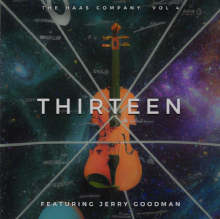The Graham Album Review #2259

Click on CD Cover for Audio Review in streaming mp3 format | |
The Haas Company Vol. 4: Thirteen
(Psychiatric Records, as broadcast on WVIA-FM 10/22/2025)

Click on CD Cover for Audio Review in streaming mp3 format | |
The Haas Company Vol. 4: Thirteen
(Psychiatric Records, as broadcast on WVIA-FM 10/22/2025)
Jazz-rock fusion arose over 50 years ago with a number of veterans of Miles Davis’ electric bands separately building on the groundwork laid by Davis and which came to enjoy a fair amount of success among rock fans with the electric nature of the music, with groups like Weather Report, Return to Forever, Herbie Hancock’s Headhunters band, and the Mahavishu Orchestra. This week, we have a new recording that nicely embodies the electric, energetic fusion of the 1970s, and happens to include one of the original members of the Mahavishu Orchestra. It’s the Haas Company, lead by drummer Steve Haas, and the album is called Thirteen. It’s the fourth album within a the last few years by the group, whose personnel has varied somewhat.
Steve Haas is a Texas native and Houston resident, whose has been playing jazz-rock fusion since his teens. He has been also a business entrepreneur, which takes much of this time. But since 2010, he has been working with his group the Haas Company, whose frequent members include keyboardist Pete Drungle, who has composed for film, video and museums, and once did a 24-hour continuous piano improvisation. Drungle wrote the compositions on this album and served as producer. Others on Thirteen include Swedish guitarist Samuel Hallkvist, and bassist Kirwan Brown, who has performed with a number of notable jazz musicians. A prominent member of the group for this album is electric violinist Jerry Goodman, who, as mentioned, was a founding member of John McLaughlin’s Mahavishunu Orchestra. Another interesting participant in this project is Sean Lennon, son of John Lennon and Yoko Ono, who plays bass on one of the tracks.
The music on the album is rather classic fusion in style, very electric with shredding guitars and wailing electric violin, along with complex compositions with shifting or unusual time signatures, and opportunities for extended solos. Though interestingly, leader Steve Haas hardly solos at all on his album.
Each of the six fairly lengthy tracks on the album has plenty of opportunities for arrangements with various sub-sections and soloing. Opening is a piece called Incident at the Country Club which is in classic form, with virtuosic playing and chances for the band members to stretch out. <<>>
A track called Five Seven Loop, as its name suggests, shifts between a five-beat and seven-beat rhythm. It’s a bit more laid back than some of the other tunes, though that is relative. <<>> Keyboard man Pete Drungle gets the biggest solo opportunity. <<>>
Back Door Party is rather like spacey funk. Though it’s not the most interesting track, it provides a lengthy solo for guitarist Samuel Halqvist. This is the track with Sean Lennon on the bass.<<>>
The title piece Thirteen begins its journey with sonic atmospherics <<>> before going all out on high energy shredding. <<>>
I think the best track on the album is called This Thing Ain’t Gonna Suck Itself. It has all the strengths of good jazz rock fusion, impressive musicianship, and an interesting composition with creative musical contrasts. <<>>
The album ends with Sleepwalker which cranks it up to 10, and features a good round of solo exchanges among the guitar, violin and keyboards. <<>>
More than fifty years after the emergence of electric jazz rock fusion from groups like the Mahavishu Orchestra, Steve Haas and the Haas Company have created an album that carries on the sound, with the help of one of the original members of the Mahavishu Orchestra. It’s all out electric fusion, though perhaps a bit more restrained and focused then some of the early examples of the sound. It’s nicely played and the compositions are generally quite good, offering interesting musical moments beyond the improvisation.
Our grade for audio quality is about an A-minus for a good mix with everything in its proper place and no added grunge beyond the guitar and electric violin shredding, though dynamic range could have been better to better capture the ebb and flow of the performances.
For those who well remember the pioneering jazz rock fusion of the 1970s, the Haas Company’s Thirteen provides a lot of authenticity with some 21st Century sensibilities.
(c) Copyright 2025 George D. Graham. All rights reserved.
This review may not be copied to another Web site without written permission.
 To Index of Album Reviews | To George Graham's Home Page. | What's New on This Site.
To Index of Album Reviews | To George Graham's Home Page. | What's New on This Site.